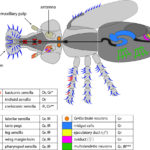Paper, Drosophila chemoreceptors: A molecular interface between the chemical world and the brain
Chemoreception is essential for survival. Feeding, mating, and avoidance of predators depend on detection of sensory cues. Drosophila contains diverse families of chemoreceptors that detect odors, tastants, pheromones, and noxious stimuli, including receptors of the Or, Gr, IR, Ppk, and Trp families. We consider recent progress in understanding chemoreception in the fly, including the identification of new receptors, the discovery of novel biological functions for receptors, and the localization of receptors in unexpected places. We discuss major unsolved problems and suggest areas that may be particularly ripe for future discoveries, including the roles of these receptors in driving the circuits and behaviors that are essential to the survival and reproduction of the animal.
Learn about our two Decals!
 Click here to find out more about our Fall Bioinspired Design Decal and our Spring Bioinspired Design in Action Decal – ALL MAJORS are welcome.
Click here to find out more about our Fall Bioinspired Design Decal and our Spring Bioinspired Design in Action Decal – ALL MAJORS are welcome.Berkeley BioDesign Community
 Click here to learn about the BioD: Bio-Inspired Design @ Berkeley student organization or here to signup for more info.
Click here to learn about the BioD: Bio-Inspired Design @ Berkeley student organization or here to signup for more info.Search
Student Login





I imagine that the neurological circuits underlying these processes are governed by both 2d spacing maps with their brains as…
to reduce the impact of car accidents, it may be possible to study the force diverting physics of cockroaches to…
you see this type of head-bobbing stability in many avian creatures related to pigeons like chickens. the head ability to…
not like they taught horses how to run! this is an example of convergent evolution where both sea creatures and…
The brain functions in a similar way with neuronal connections. our brains are able to utilize the multiplicity of connections…